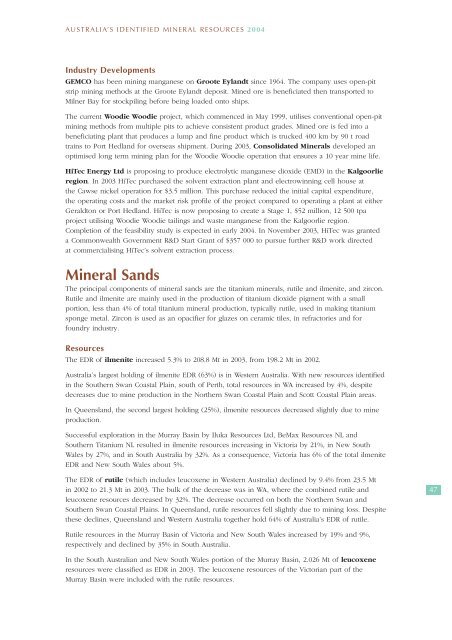australia's identified mineral resources 2004 - Geoscience Australia
australia's identified mineral resources 2004 - Geoscience Australia
australia's identified mineral resources 2004 - Geoscience Australia
Create successful ePaper yourself
Turn your PDF publications into a flip-book with our unique Google optimized e-Paper software.
AUSTRALIA’S IDENTIFIED MINERAL RESOURCES <strong>2004</strong><br />
Industry Developments<br />
GEMCO has been mining manganese on Groote Eylandt since 1964. The company uses open-pit<br />
strip mining methods at the Groote Eylandt deposit. Mined ore is beneficiated then transported to<br />
Milner Bay for stockpiling before being loaded onto ships.<br />
The current Woodie Woodie project, which commenced in May 1999, utilises conventional open-pit<br />
mining methods from multiple pits to achieve consistent product grades. Mined ore is fed into a<br />
beneficiating plant that produces a lump and fine product which is trucked 400 km by 90 t road<br />
trains to Port Hedland for overseas shipment. During 2003, Consolidated Minerals developed an<br />
optimised long term mining plan for the Woodie Woodie operation that ensures a 10 year mine life.<br />
HiTec Energy Ltd is proposing to produce electrolytic manganese dioxide (EMD) in the Kalgoorlie<br />
region. In 2003 HiTec purchased the solvent extraction plant and electrowinning cell house at<br />
the Cawse nickel operation for $3.5 million. This purchase reduced the initial capital expenditure,<br />
the operating costs and the market risk profile of the project compared to operating a plant at either<br />
Geraldton or Port Hedland. HiTec is now proposing to create a Stage 1, $52 million, 12 500 tpa<br />
project utilising Woodie Woodie tailings and waste manganese from the Kalgoorlie region.<br />
Completion of the feasibility study is expected in early <strong>2004</strong>. In November 2003, HiTec was granted<br />
a Commonwealth Government R&D Start Grant of $357 000 to pursue further R&D work directed<br />
at commercialising HiTec’s solvent extraction process.<br />
Mineral Sands<br />
The principal components of <strong>mineral</strong> sands are the titanium <strong>mineral</strong>s, rutile and ilmenite, and zircon.<br />
Rutile and ilmenite are mainly used in the production of titanium dioxide pigment with a small<br />
portion, less than 4% of total titanium <strong>mineral</strong> production, typically rutile, used in making titanium<br />
sponge metal. Zircon is used as an opacifier for glazes on ceramic tiles, in refractories and for<br />
foundry industry.<br />
Resources<br />
The EDR of ilmenite increased 5.3% to 208.8 Mt in 2003, from 198.2 Mt in 2002.<br />
<strong>Australia</strong>’s largest holding of ilmenite EDR (63%) is in Western <strong>Australia</strong>. With new <strong>resources</strong> <strong>identified</strong><br />
in the Southern Swan Coastal Plain, south of Perth, total <strong>resources</strong> in WA increased by 4%, despite<br />
decreases due to mine production in the Northern Swan Coastal Plain and Scott Coastal Plain areas.<br />
In Queensland, the second largest holding (25%), ilmenite <strong>resources</strong> decreased slightly due to mine<br />
production.<br />
Successful exploration in the Murray Basin by Iluka Resources Ltd, BeMax Resources NL and<br />
Southern Titanium NL resulted in ilmenite <strong>resources</strong> increasing in Victoria by 21%, in New South<br />
Wales by 27%, and in South <strong>Australia</strong> by 32%. As a consequence, Victoria has 6% of the total ilmenite<br />
EDR and New South Wales about 5%.<br />
The EDR of rutile (which includes leucoxene in Western <strong>Australia</strong>) declined by 9.4% from 23.5 Mt<br />
in 2002 to 21.3 Mt in 2003. The bulk of the decrease was in WA, where the combined rutile and<br />
leucoxene <strong>resources</strong> decreased by 32%. The decrease occurred on both the Northern Swan and<br />
Southern Swan Coastal Plains. In Queensland, rutile <strong>resources</strong> fell slightly due to mining loss. Despite<br />
these declines, Queensland and Western <strong>Australia</strong> together hold 64% of <strong>Australia</strong>’s EDR of rutile.<br />
47<br />
Rutile <strong>resources</strong> in the Murray Basin of Victoria and New South Wales increased by 19% and 9%,<br />
respectively and declined by 35% in South <strong>Australia</strong>.<br />
In the South <strong>Australia</strong>n and New South Wales portion of the Murray Basin, 2.026 Mt of leucoxene<br />
<strong>resources</strong> were classified as EDR in 2003. The leucoxene <strong>resources</strong> of the Victorian part of the<br />
Murray Basin were included with the rutile <strong>resources</strong>.

















